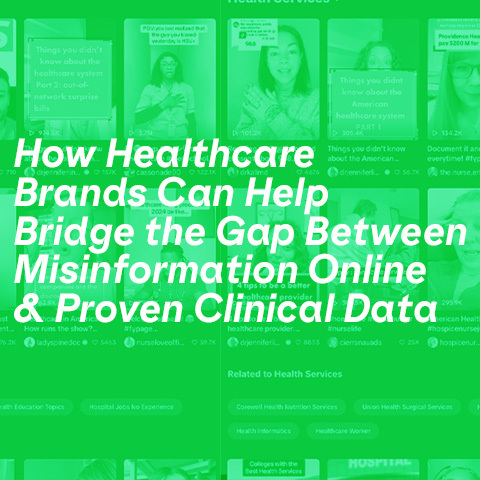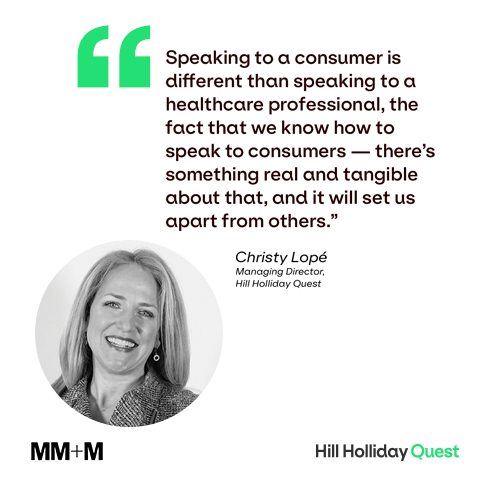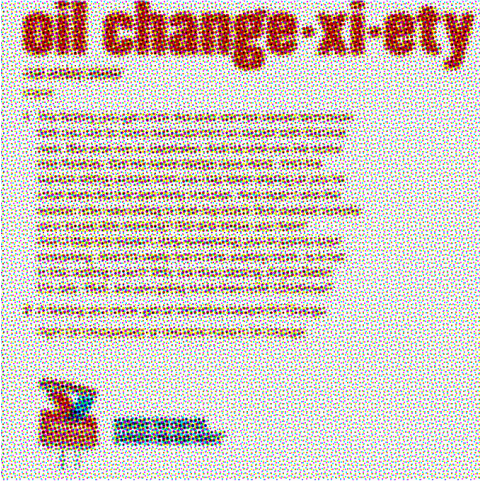

How to win big during Black Friday and beyond
Contributors: Christopher Van Mossevelde & Jeffrey Cavallo
Black Friday and Cyber Monday (BFCM) might dominate the retail calendar, but they aren’t the only opportunities for your business to shine. Jeffrey Cavallo, EVP of Decision Science at Hill Holliday, shares how companies can leverage year-round opportunities using data-driven strategies and creativity. Here’s how to win big during BFCM and beyond.
With BFCM generating billions of dollars in sales, the competition for consumer attention has never been fiercer. Yet, while big-box retailers like Amazon, Target and Walmart thrive, others struggle to out-shout the competition. How can small and mid-cap businesses get the most out of this period?
We sat down with Jeffrey Cavallo from Hill Holliday, a marketing leader with more than 14 years of experience. We discussed how data-driven insights and creativity can help businesses navigate the BFCM period and find other moments in the year to drive sales.
Hill Holliday is a 56-year-old marketing agency based in Boston with an additional office in New York. The agency offers a full range of marketing services, including creative, media, strategy and data analysis.

Jeffrey Cavallo, EVP of Decision Science at Hill Holliday
Leverage data to drive campaign success
Jeffrey Cavallo heads Hill Holliday’s Decision Science group, specializing in consumer research and marketing analytics. This centralized group collaborates closely with the agency’s media team to validate client investments in media and support the creative and strategy teams through primary research and quantitative methods.
In addition to campaign planning, the Decision Science team also manages Hill Holliday’s data strategy and fosters strategic partnerships with companies like Funnel and others in the MarTech industry. These efforts ensure the agency stays ahead of the curve by integrating modern technologies into its marketing process.
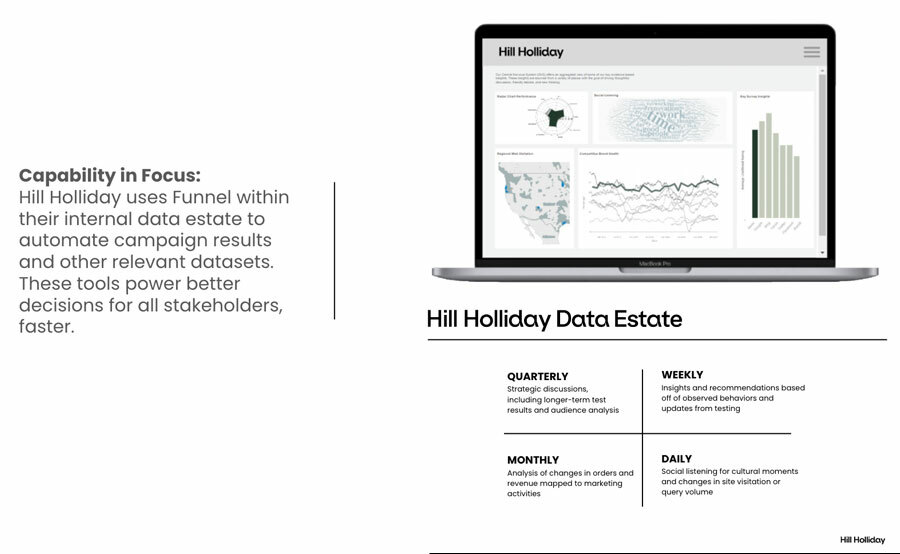
Understanding consumer behavior year over year
When it comes to BFCM, Hill Holliday focuses on understanding how consumer behavior changes from year to year. According to Jeffrey, consumers now expect deals over a more extended period, so it’s crucial to identify when they start anticipating discounts.
Analyzing historical data
Hill Holliday analyzes data from the past three years to see when consumers started visiting clients’ websites or searching their categories. By identifying popular products, they tailor future campaigns for maximum impact.
In particular, the Decision Science team has developed a flight simulation tool that uses signals like website activity, store visitation data and category search data to understand when interest in their client’s category is expected to rapidly grow. They also look at public search data and competitive spending data to analyze the response to their advertising.
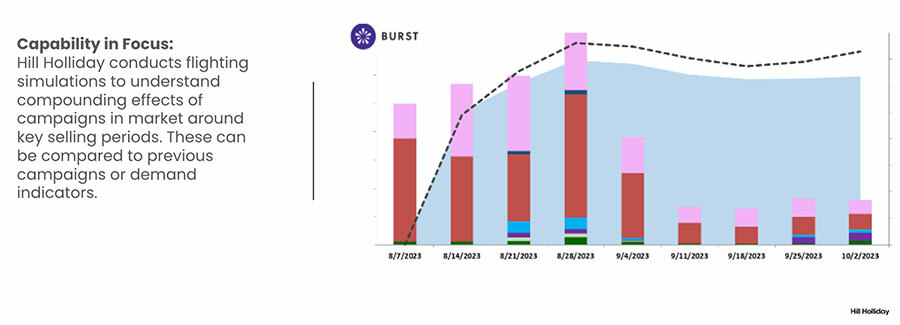
“We look to past Black Friday / Cyber Monday pushes and how quickly we saw a response afterward,” Jeffrey said. “We aim to optimize client flighting to achieve breakthrough levels when customers are signaling peak interest for the most immediate response. These analyses are more critical than ever as brands face a compressed season bookended by a November election and one fewer weekend for December holiday shopping.”
Jeffrey and his team focus on understanding category behaviors for many of their clients, some with limited budgets, to ensure they are not too far ahead or behind in their marketing and digital advertising.
When measuring outcomes, they strive to understand which verticals and products (such as durable goods like furniture and bedding) were most sought after by consumers. Based on last year’s consumer behavior, they also focus on specific products and collections while anticipating the demand for these verticals and products in the coming year.
Expert tip: Analyze your historical data to identify the best timing for your campaign push. Review the last three years of trends, focusing on when consumers started engaging with your category. Implement automated alerts in your analytics tool (such as Google Analytics or Shopify) to capture real-time spikes in consumer interest.
By adjusting your campaign’s timing (e.g., starting ads slightly earlier or later), you can maximize the effectiveness of your spend and generate the best immediate response in terms of sales or engagement.
Align your marketing to business operations
Jeffrey also had a few pointers to identify and overcome bottlenecks during the BFCM period.
“COVID was a wake-up call for many marketing departments,” Jeffrey explained. “It showed us just how critical it is for marketing to be tightly connected to operations, especially when it comes to headwinds like supply chain challenges.
“Big-box retailers have been operating with a strategy that relies on product availability, but the pandemic has shown how supply chain challenges can significantly impact marketing effectiveness.”
Therefore, Hill Holliday encourages CMOs and marketing clients to integrate more closely with their organizations. By establishing routines, habits and products to support collaboration, they ensure that marketing and operations work together more effectively. This also ties back to Funnel, where information drives insight.
“By creating transparency around what is working and how consumers are responding, marketers can have more informed discussions with operations and supply chain teams. This includes understanding current inventory levels and expected availability of key products and making informed decisions about how aggressive we should be in our marketing based on this information. Ultimately, this approach aims to prevent wastage of resources on products that are not available,” explained Jeffrey.
Break down data silos and promote marketing as an investment
At Hill Holliday, the Decision Science team works as a centralized group so that everyone in the organization understands the effects of the decisions they make as an agency on behalf of their clients. On the client side, they prepare their partners with the insights and solutions for marketing teams to take a lead role.
“We see this across organizations, with CMOs and CFOs working more collaboratively than ever before. Our job, as agents of our clients, is to promote marketing as an investment, not as a cost,” Jeffrey explained.
Jeffrey pointed out that the availability of data allows marketing to lead the organization’s learning agenda and to understand the consumer better than anyone else.
“We are providing our marketing leads with more consumer insight than ever before, encouraging curiosity and providing transparency of results. This enables them to be the champions of understanding who the organization should be building around, what’s driving consumer response and where to invest next. This broadens the utility of marketing groups, and it all starts with transparency and data availability,” Jeffrey explained.
Expert tip: Promote marketing as an investment leader by using data transparency and collaboration with other departments (e.g., finance and operations) to demonstrate how marketing drives growth across the business.
Balance new customer acquisition with retention
When maximizing marketing impact, Jeffrey sees a growing trend among small and mid-cap brands to create more selling opportunities beyond Black Friday.
“There’s an expectation that larger retailers like Amazon, Target and Walmart will overshadow these brands. However, heavily discounting products during these peak periods may not provide much value for existing customers, as it can reduce profit margins and the return on marketing investment,” Jeffrey said.
As a result, he explained that many brands are seeking ways to generate interest, engagement and sales outside of these key selling periods. Hill Holliday uses their tools to identify other moments when brands can remain relevant throughout the year.
Although attracting new customers is certainly a priority for many, a trained data strategy can create real potential in cultivating loyalty among repeat customers. By doing so, brands can demonstrate the value they place on their customers and offer a more personalized experience based on the customer’s preferences. According to Jeffrey, this personalized approach can serve as an alternative to steep discounts provided to new customers, thereby encouraging repeat purchases.
To achieve this, brands are exploring cost-effective methods such as newsletters, emails and customized texts. The primary focus is on implementing strategies to engage existing customers, as there appears to be a greater opportunity to retain these customers rather than competing with major retailers for new customers.
Go beyond your typical marketing metrics
When it comes to measuring the effectiveness of their campaigns, Jeffrey explained the traditional measures will always be in place.
“We need to compare dollar for dollar sales with last year. We also need to be accountable for whether we were able to lower customer acquisition costs and drive increased lifetime value among existing customers,” he said.
However, aside from the typical metrics in the retail and e-commerce space, Jeffrey mentioned that there has been a big push to lift the profile of their clients’ brands, their recall and consumer perceptions – especially early in the BFCM holiday season.
According to Jeffrey, they are seeing a lot of those sales being spread across the entire months of October and November not just Thanksgiving and into December. Therefore, it’s important to assess how well they used their marketing dollars to build perception early in the selling period so that they can maintain relevance throughout the holiday season.
“This may have been undervalued in the past, where the focus was solely on ROAS, comp sales and new customer origination. While these indicators remain vital , with the abundance of discounting and clustering of messages, breaking through is going to be critical,” he said.
As for whether or not they can connect campaign performance to real profit, Jeffrey explained that they maintain an internal data system within the agency that channels all their campaign data and matches it with their clients’ first-party customer data in an aggregated and anonymized manner. This has enabled them to attribute how effectively their marketing budget is contributing to campaign performance.

Focus on your audience no matter what
This year will be different from last. Jeffrey pointed out that they need to consider the upcoming US election, which will have a significant impact on Black Friday sales.
“We apply our flighting tools to ensure they are running at full speed when interest in their category peaks,” he said. “The media landscape leading up to the election will be cluttered, posing a challenge for advertisers trying to capture consumer attention. As we approach the holiday season, it will be crucial to create relevance early and maintain brand recall.
To break through, the primary research the team completes really helps their clients understand consumers’ relationships with their brand during the season and their discretionary spending habits. They look at economic indicators such as consumer confidence and the propensity to trade up or down and identify where consumers are willing to compromise. These indicators inform their strategy.
However, it’s important to note that not all consumers have the same spending habits and preferences. Therefore, Hill Holliday typically adopts an audience-first approach and invests in audience technology to understand consumer mindsets and values during different selling periods. This allows them to customize their approach for various consumer segments. For example, some consumers may invest substantially in one key item, such as big-ticket electronics while opting for discount stores for other items. “We use different messaging for these consumers than those interested in a suite of products and accessories,” Jeffrey explained.
According to Jeffrey, a bespoke approach to audience targeting is crucial, as businesses cannot assume that external factors like elections or inflation will impact all consumers in the same way. For example, despite substantial credit card debt, consumers are still willing to invest to ensure they have plenty of gifts under the tree this year.
“It’s important to account for these factors on a granular level, ensuring that your messaging speaks directly to different audience segments rather than making broad assumptions,” Jeffrey said.




